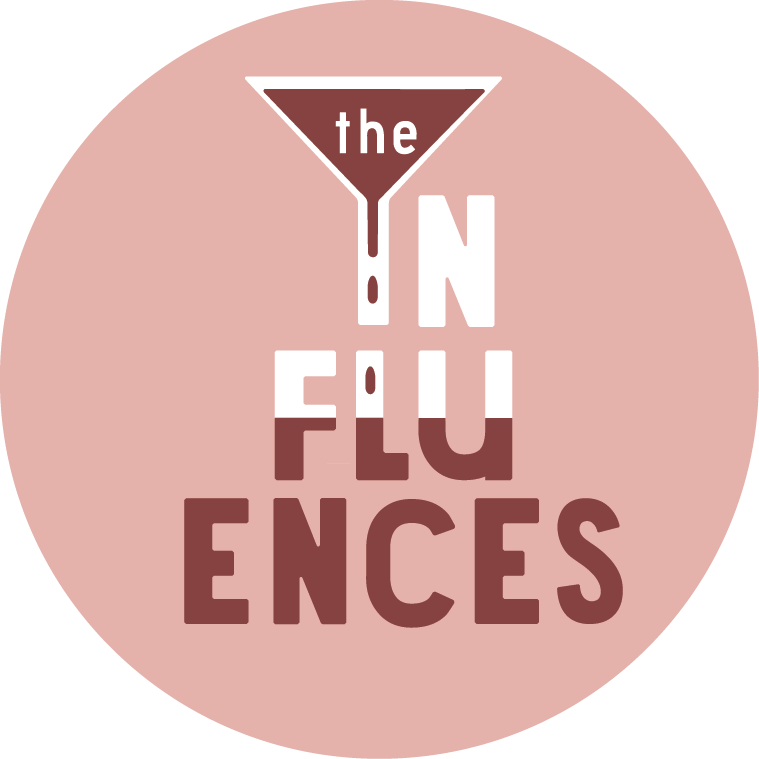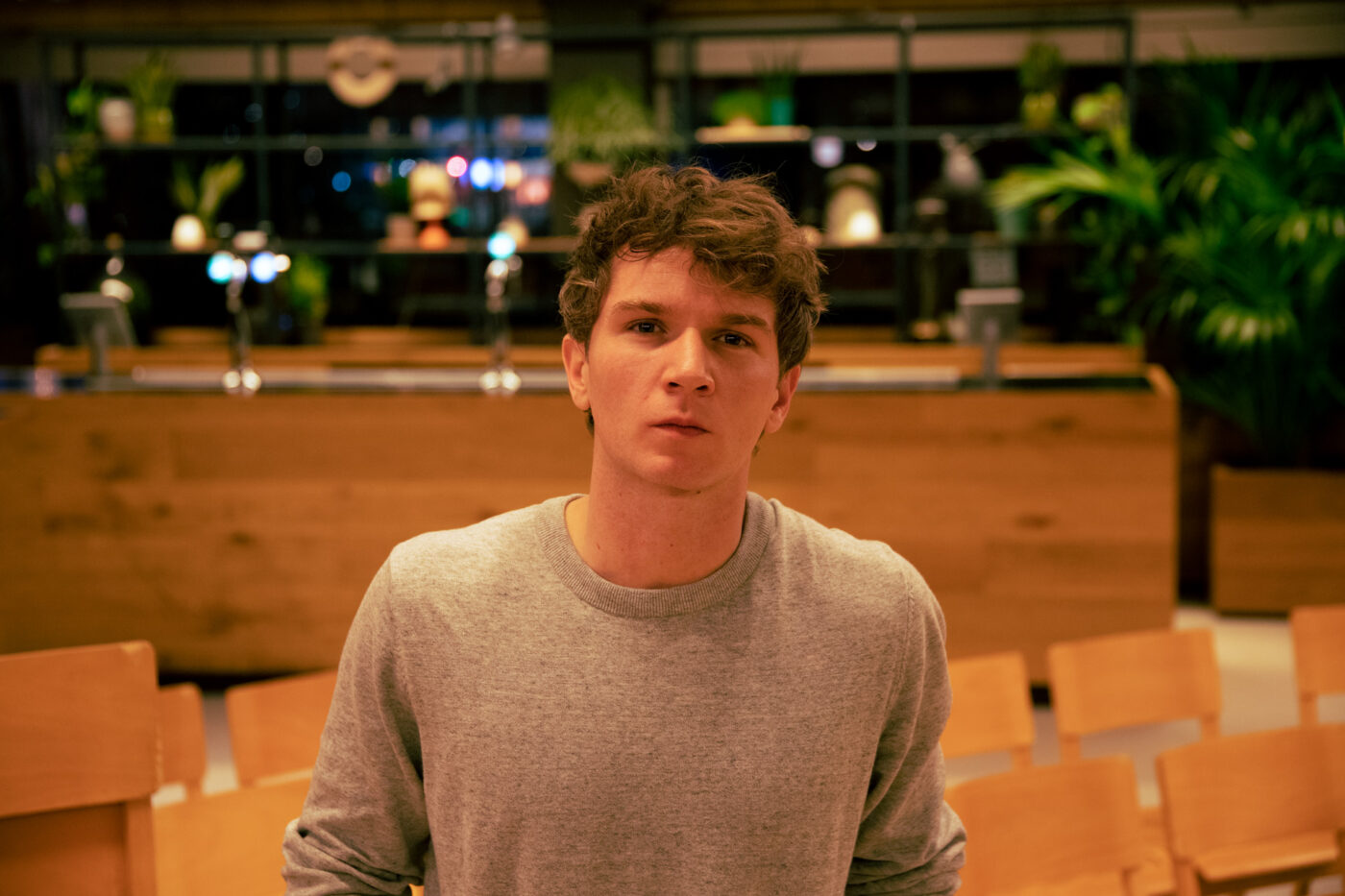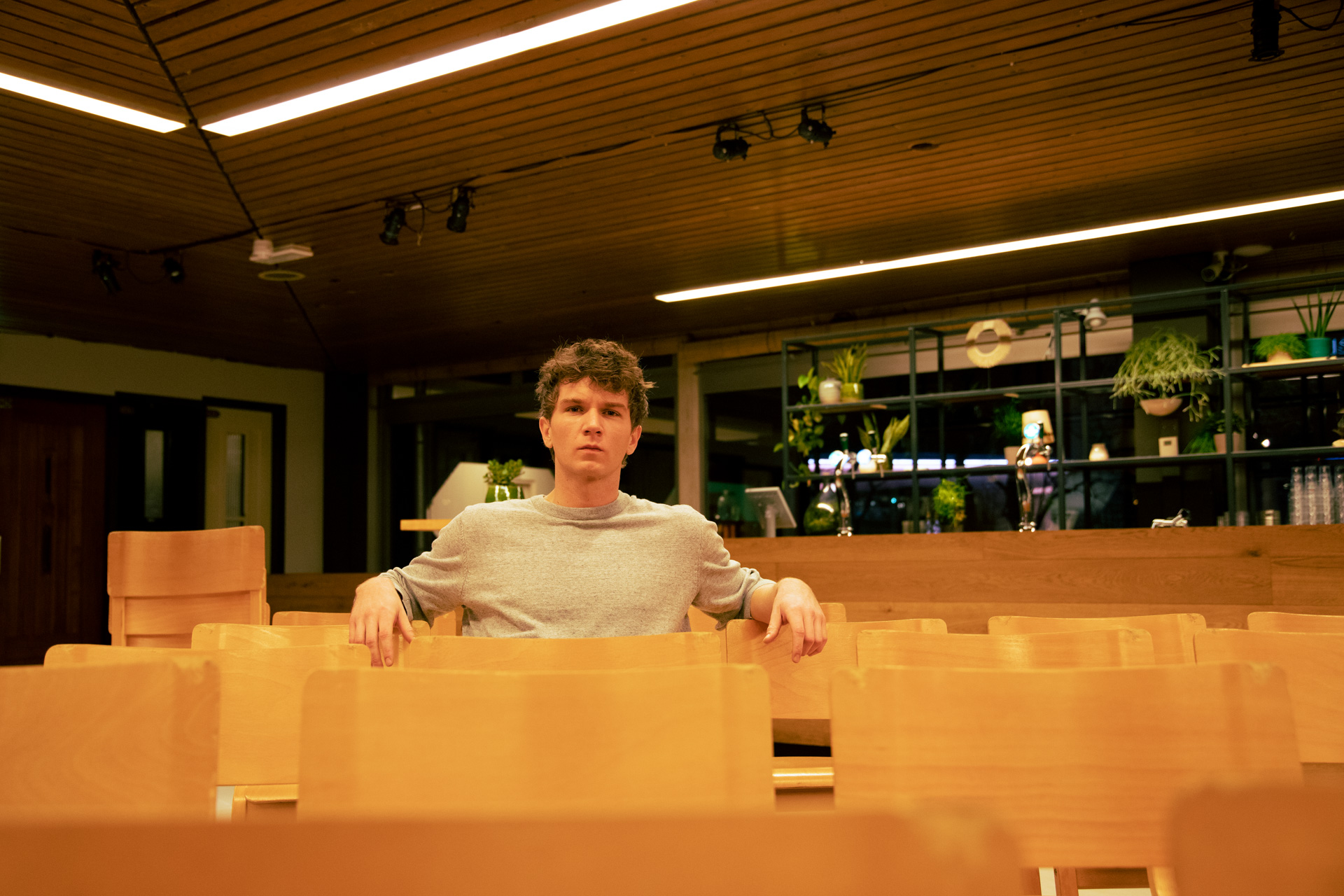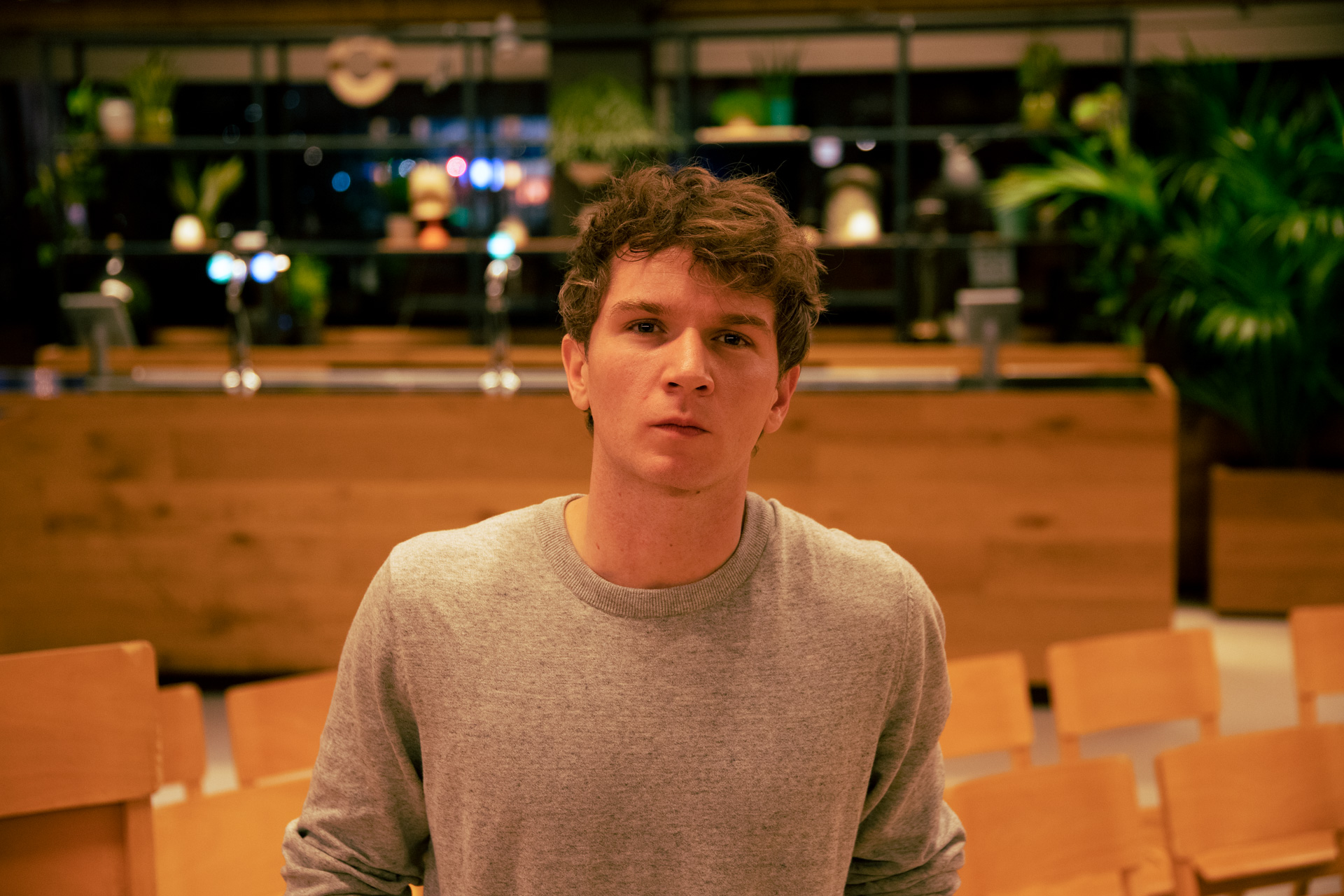Days before the world ground to a halt, Kentuckian songwriter Ian Noe recorded a session for The Influences. We met at Paradiso Noord in Amsterdam and filmed three songs after his soundcheck; his own Loving You and covers of John Prine’s Hello In There and Merle Haggard’s If We Make It Through December. Noe, who has finished a new record in the meantime, calls these recordings the best video recordings anyone ever made of him. Well, thank you, and the pleasure was all mine – since his 2019 debut record Between The Country was an instant favorite of mine. Watch the session below and read the interview we had last week about his development as a songwriter, the beauty of Kentucky and the influence that was John Prine.
Fire on the wheels
“I remember standing in the hotel right before we left to the airport to fly back home, and the news broke about this virus that came out. It just snowballed from there. Who would have thought almost two years later here we still would be? That European tour we wrapped up was so good, it was maybe my favorite tour I’ve done. And it felt like I had some fire on the wheels, because I had a tour planned for the States when we got back, but all that stuff got wiped out obviously. It was whiplash, really. But we’ve all been in pretty much the same boat, so it’s just what it is.”
Ian Noe has been spending his time in Bowling Green, Kentucky, an hour North of Nashville, and has kept himself busy for the past year and a half. “I’ve been alright, working on new stuff has kept me partly sane through all this. I just got the test pressing for my new record, so I’ve been listening to that for the last couple days.”
Writing
“I’m very happy with the test pressing. It becomes cemented when you can hold it in your hand and the sound isn’t coming out of the phone you know. And that’s the test for me, putting the vinyl test pressing on. If that’s solid then everything else is peaches and cream. So yeah, very happy with it. I can’t wait for you to hear it.”
Noe recorded the album over the course of 2019 and 2020, and had it mastered by July of this year, so it took a couple of years altogether. The record will be a mixture of songs written before and during the pandemic. A different approach than on Between The Country, which was recorded by Dave Cobb in Nashville. “With Dave, we went and knocked it out in seven days, recorded and mixed. Two weeks, if you include the mastering. This time I ended up going to a place called the Bomb Shelter, run by Andrija Tokic who recorded Alabama Shakes’ first album. I’ve always wanted to go and work with him, plus he works strictly to tape. It was a different experience and I enjoyed having no set time on how long I can work on a song, that way I can flesh it out. I think we recorded close to twenty tracks all together. Nothing against Dave Cobb’s process which was great too, but it was fun working on this one, it really was.”
This time writing was a little bit different, because Noe didn’t have any shows, he tells me on Zoom. “So thank god that I had a guitar and could write, because that’s what I’ve always done anyways. I now just had all the time to do it. For a little while I was trying to write nothing dark, even though we’re in the midst of all this and it’s everywhere you turn. I’ve still been trying to do that but the times are the times. More or less my writing’s not changed too dramatically from what it was.”
The beauty in the ordinary
It’s really no wonder Ian Noe cites John Prine as one of his main influences. Their songs share a finger picking style and the art of using seemingly ordinary things to form a striking image of a situation. Prine used a bit more humor, but in both of their songs you’ll find a lot of compassion for the people and situations they describe. “Well a song like If Today Doesn’t Do Me In off of my first record is pretty much like what you just said; I think of somebody in a situation, but what I’m really doing is I’m thinking about myself really. I’m just putting it in different characters. I don’t find it hard to write like that. It’s actually my favorite way, because if I get two lines or even one line and it’s solid enough, I know that it’s going to be solid enough the next day and the day after that.” The first line is absolutely the hardest line to get, Noe explains. “I’ve gotten the second and third verse to many songs before I ever got the first verse. And that’s all about thinking about situations and people and putting them here and putting them there. Then it’s really like a puzzle to where you can hopefully make it all come together. That’s when it comes down to editing a song and I enjoy that process a lot.”
“John Prine was hands down the best that will ever be at doing what you just described; capturing those feelings that we all feel. In his songs it comes out so effortless. I mean, it’s just so solid that it sounds like it’s always been there. If you can get into that hole, that part of it and you can capture it, it’s good. When you can get a simple line that might be considered profound, you know, something like that. You can go all day long and write the most pretentious lines. I mean that’s all that I ever did when I first started out when I was fourteen. I had no idea what I was doing, I was like: how smart can I sound? You just end up sounding like a dumbass, because you don’t know what you’re talking about. It’s all pretentious. It took time, people would always say: ‘you just keep writing, keep writing, keep writing’. And I never really got discouraged with hearing that because I knew if I kept going I would stumble onto something. You realize: I don’t have to spend a whole verse describing the kitchen sink or the fly on the wall.”
As far as the writing goes, Ian Noe likes to get the melody first. “Follow that melody and see what it feels like and see what situation would fit that melody. I have to be able to read it on the page without any music, with the melody in my head. The words need to have a rhythm to it and there can’t be anything out of place. The words can’t skip a beat. That’s just how I do it.”
John Prine was pretty good.
“John Prine had many lyrics that are really funny as well. He could turn that on and off like a faucet, he was so good. And he could do every emotion in one three-minute song. It’s been said a million times but it’s because it’s the truth. I’m still trying to incorporate more of that side into the harsh parts of reality that is Eastern Kentucky. This next new album is the flip side to Between The Country for me, for sure. There’s just a lot more positive songs on it and I’m really happy with that. It’s not so easy to hit the mark on the funny stuff, but I think it worked out pretty good.”
Pretty much during the filming of this session, the news came in that some of the upcoming shows where Ian Noe and Kelsey Waldon – who recorded her The Influences session earlier that day – were supposed to open for John Prine were cancelled. “I did get to open for him on that trip though. If I’m not mistaken, the first show got cancelled because of his hip, but I got to open for him in Sweden. John had to sit down and he told me it forced him to tell more stories and play slower songs. Songs he hadn’t played in years, and I played one with him called Come Back To Us Barbara Lewis, a great song.”
“He was one of my biggest influences, if nothing else for the finger picking alone. I only learned how to finger pick because of John Prine. If you want to learn that, go pick out three Prine songs and you will quit or you’ll get better. I believe he was a very humble man, I’m not going to sit here and pretend like I knew him personally, because I did not. I always played with three fingers and I always assumed that he did too. But he didn’t, he played with two fingers! He did all that with two fingers, and here I was trying to get it down with three fingers. He talked about his finger picking style like it was just what he could do, but it was so much more than that. It was just genius. Hello In There is the first song I used to learn finger picking. That was the one.”
Like the gates opened up.
“My dad and my grandfather sat around all the time and played John Prine songs. I heard all those songs that they were singing and they would say: ‘yeah this is John Prine’, but up until that point when I was about ten years old I had never actually heard John Prine sing one of the songs. I was in my grandpa’s basement and I found the Greatest Hits album. I’d heard my dad do Hello In There before, and I love my dad to death, but you know no offense, when I put on Prine for the first time, it was like the gates opened up. This was the greatest thing I’d ever heard. I took the record and recorded it to a cassette, ran upstairs my grandparents’ house, stuck it in the cassette player, immediately went to Hello In There and I just sat there and I listened and thought: ‘I have to try to figure out whatever is going on here’. And to this day it’s still my favorite song of all time. I’ve listened to that more than any other song. It never ever gets old. You hear a lot of people bring up that song, but that’s how powerful that song is. The melody is absolutely perfect to those lyrics, he just hit the nail. If he had never written anything else but Hello In There, I think he should have gone down as one of the best songwriters ever. I don’t think I’ve ever heard a song that even resonates close to the way that this does. It’s just that big for me. John Prine doesn’t have a bad record, not even a bad song. Even his songs that not a lot of people know are still great. Because it was just his personality coming out through them and it was so magnetic. He could do no wrong in my book.”
People connecting to his own songs.
“For me personally, when I write a song, I’m satisfied if it’s what I set out to do and I can honestly say that I’m happy with it. So when I get comments, or somebody will send me an email or a message, and they’ll write this really nice thing about how this song helped them… it’s great. I don’t know. That’s really all I can say about it, I know it’s not a really good answer, but that’s what you at least hope for. When somebody really cares, it means a lot.”
Ian Noe never really toured a lot, and he had never been to Europe before, up until the last four or five years. “When I was sixteen to nineteen years old, I made two records, that I recorded right in my bedroom, all acoustic. They were what they were you know. I would hit little spots in Eastern Kentucky, sometimes I would go to Ohio and play a few shows, but that’s about the extent of my touring up until the last five years.”
You could call him a late bloomer, and it might have something to do with a dry spell in his early twenties. “There’s a big gap where I really didn’t write a lot. I was working in office jobs before I worked in the oil fields. Maybe it was the mundaneness of working an office job in my hometown for a year and a half when I was 22. I ended up moving to Louisville Kentucky working as a grunt, just hanging drywall and all that type of stuff. I moved up there for music, to record. But you need to have money to record, and you have to have money to pay the rent, you know how that goes. I got discouraged with that and ended up moving back home after a little bit over a year in Louisville. I went back to the same office job I had before for about another eighteen months, and then I landed that job in the oil fields. It afforded me to work on music, because I could work on a bulldozer or a backhoe and have the songs that I was working on from the night before in my headphones. The process of working and writing at night and then listening to it the next day at work, that’s how I wrote all of Between The Country.”
“Maybe what caused me to really start writing was when I got Irene down. When I wrote that, that was a big boost to keep going. Junktown was a big one for me too, because it gave me confidence to try and top it. Which is what I always try to do. Not top it per se, but make sure every new song is up there, you know? Not every song is going to be Brown Eyed Girl, but that’s how I frame it in my head to keep working. I really started picking it back up and really focusing on what a good song is. And sometimes you can’t put your finger on it, but you have to write a decent song to understand what it is. It’s like a world opens up.”
It hits everybody different.
“And as far as people connecting with the songs, it’s great. But I found it fascinating that my songs remind people of all kinds of different things. I’ve heard people say: ‘You remind me so much of John Denver, you remind me so much of Don McLean, you remind me so much of Chris Stapleton.’ And I sound nothing like any of these people, so that’s been interesting. It hits everybody different. I figured people would have said Neil Young or somebody like that, and that hardly ever comes up. Which is funny because I tried to put a little influence of that in Letter To Madeline. People are going to hear it how they hear it. As long as they like it it’s all right with me.”
Kentucky.
“Kentucky is beautiful. I mean there’s no two ways around it, it’s home for me. I find it to be the most inspiring place for me to write. If I’m in Colorado, more often than not I’m thinking about home. My songs are usually set around here and it’s just a good design to have. I feel fortunate being born in Kentucky honestly, because it’s influenced pretty much everything that I’ve done musically. These last few years we’ve had a lot of really good artists come out of Kentucky, it’s always kind of been like that. I would say it’s the main influence on my music for sure. Where I’m from it’s all mountains pretty much, in Eastern Kentucky and over all the way to Virginia. You get toward the middle of Kentucky and over more West you really get into that bluegrass and you get into the bourbon country and you get into the horses and all that.”
Merle and his father.
“Merle Haggard is my number one guy when it comes to country music. Me and my grandfather before he passed away used to go riding all day long and listen to Merle Haggard. We listened to If We Make It Through December so many times. It was another one of those songs where the finger picking drew me to it. It has to be my favorite Merle song. It’s got that vein of Hello In There, it’s got that perfect melody with the perfect lyrics to it, that you can’t hear it any other way. When you get a song that good it just becomes a monument and there’s nothing you can do about it. That was always the song that my grandpa asked me to play for him when we were picking around, so that’s why I keep it in the rotation.”
“My father and my grandfather only played around the house, but they’re damn good. My dad’s still very good and he taught me to play guitar. He always had a Martin in the house, for as long as I can remember. My dad still writes songs as well, he’s very good and I keep telling him to record them. I’d say: ‘Let’s book some studio time, let’s go down there and put these down.’ He always tells me I should record his songs and I reply: ‘It’s your song and you don’t do a half bad job at it.’ I think that the studio is almost a foreign concept to him, but maybe I’ll convince him one day. I hope so, because he’s a good writer for sure.”
Photos
Originals
Hello In There (John Prine)
Spotify | Apple Music
If We Make It Through December (Merle Haggard)
Spotify | Apple Music
Ian Noe
Credits
Filmed & edited by Matthijs van der Ven.
Audio recorded & mixed by Matthijs van der Ven.
Location
Paradiso Noord
Amsterdam, The Netherlands
Thanks
Paradiso Amsterdam
Kelsey Waldon
Sedate Bookings
Stijn Buist (Thirty Tigers)
The Hello in There Foundation is an initiative established by the family of John Prine, to honor his memory and continue the love, kindness and generosity he shared with the world. The work of the foundation will be inspired and guided by John’s simple song title, Hello In There. Our mission aims to identify and collaborate with individuals and communities to offer support for people who are marginalized, discriminated against or, for any reason, are otherwise forgotten.
There is no better way to discover music than watching great musicians cover the songs they love. The Influences has been producing these videos ever since 2008.
Read more.



